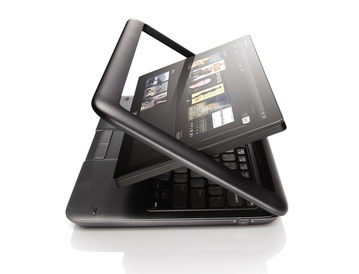Can a netbook be a tablet? Dell Inspiron Duo

Back in 2000 or so I had a wonderful machine, a Vadem Clio. Actually I still have it: it was one of the first true tablet computers, a Windows CE hybrid device that let you rotate its screen into one of three positions: as an easel, as a small notebook device and as a tablet. I've been using tablet devices ever since then, finding the hybrid of keyboard and slate a useful form factor, but the Clio's flip screen was one of a kind, sturdier than the rotating hinges that became popular for Tablet PC hybrid devices.
So it was with interest I picked up Dell's Inspiron Duo, a netbook tablet. It's the first machine I've seen since the Clio that offers a flip screen — although unlike the Clio which hinged its whole screen, bezel and all, the Inspiron Duo's flip rotates the screen inside the bezel. It's easy to switch from conventional netbook to tablet with just a simple push. That's not to say the screen is loose, it locks in place and requires a little force to get it rotating.

Used as a netbook the Inspiron Duo works well. Intel's Oaktrail and the Broadcom CrystalHD encoder make it speedy enough, and its 1,366 by 768 resolution is as good as most wide-screen laptops. Even so, it's clearly a device for content consumption rather than creation, with its tiny keys. The touchpad is small, and hard to control — although of course you do have a touch-screen. The lack of graphics power in the integrated graphics is disconcerting when compared to the quality of the video. There's a lot to be said for accelerating just one class of video output, but don't expect to play any games.
Flipped into tablet mode you get Dell's Stage user interface. Sadly it's not the Inspiron Duo's best feature: it's most definitely a consumer application, and one that's surprisingly slow. It took around 30 seconds to launch any of the Stage applications, substantially slower than other Windows applications. The tablet is a capacitive screen with two-point touch, enough for most touch applications. However we did find that the sensor resolution was lower than we'd have liked, especially when trying to use a capacitive stylus to write on the screen in Windows Journal.
The Inspiron Duo is both thick and heavy, and its wide-screen form factor makes it very difficult to use as a tablet in portrait mode. It's just too narrow, which makes it hard to use the device as an e-book reader. Things make more sense in landscape mode, where it makes an effective digital media viewer. There you also get to use Microsoft's Media Center as an alternate user interface. Designed for remote controls and using a variant of the Windows Phone Metro design language, Media Center is a surprisingly good touch interface — and if you're using the Inspiron Duo as a media consumption device we'd recommend using it over Dell Stage.
The trouble with the Duo isn't that it's a tablet: it's that it's a netbook. Intel's Oak Trail Atom CPU may be hyper-threaded and dual core, but it still doesn't have the sheer grunt of a desktop processor — or even the mobile versions of the Core series devices. Yes you've got four threads, but each of them is running an application at Atom speeds. If you don't use many applications, then that should be good enough. Atom also means you're limited in terms of memory, as it's only 32-bit.
So would I stick with the Inspiron Duo or pull my old Vadem Clio out of storage? Considering that the Clio is a decade old, the fact that I'm actually not sure is an indictment of Dell's hardware. Windows 7 Tablet PCs work well enough with more horsepower, and with better screens and digitisers. Dell, in going for the low-cost netbook market, is using low-cost components and hardware, and its choice shows. It's a pity, as Dell has done a lot better with Windows tablets in the past. Still, at least the Inspiron Duo has shown that alternate tablet form factors work — unfortunately for Dell it's also shown that they need the hardware behind them.
Simon Bisson